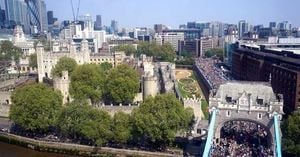Archaeologists from Newcastle University and the University of Exeter have made an exciting discovery near the village of Bosham, West Sussex, potentially locating the long-lost residence of Harold Godwinson, the last Anglo-Saxon King of England. This site is depicted prominently on the storied Bayeux Tapestry, which recounts the events leading up to the Norman Conquest of England in 1066 and is held as one of the most significant historical archaeological textiles.
The Bayeux Tapestry, measuring approximately 224 feet (68.3 meters) long, tells the dramatic tale of William of Normandy’s conquest, featuring key events such as the Battle of Hastings. Among the earliest scenes, it portrays Harold feasting at one of his manors, believed to be the very location archaeologists have now identified. This recent investigation, detailed in a study published on January 9, 2025, connects tangible archaeological evidence to historically significant embroidery.
According to Professor Oliver Creighton of the University of Exeter, the medieval remains discovered at Bosham may well be described as "an Anglo-Saxon show-home." His assertion emphasizes the rare opportunity this find presents — proving the connection between historical artifacts and real-life locations. The British researchers undertook the remarkable task of reevaluated previous excavations carried out back in 2006.
Through new surveys, map analyses, and assessments of historic records, they unearthed two provisional buildings previously unidentified, along with evidence indicating the presence of high-status elite residences from the 10th century. Duncan Wright, the lead archaeologist from Newcastle University, remarked, “The realisation ... we have found Harold Godwinson’s private power center, famously depicted on the Bayeux Tapestry.”
What’s particularly exciting about this discovery is the archaeological team identified part of Harold’s residence through the remnants of what appears to be its toilet—a rarity for homes of the period. While today, toilets may seem mundane, back then, they indicated wealth and status. Dr. Wright pointed out, “The 2006 excavations had found, ... anglo-saxon en-suite, confirmed to us...” this location once housed people of significant standing.
The search for the true site of Harold’s manor has captivated historians, with many scholars previously speculating about potential locations. By establishing the physical presence of Bosham as the residence depicted on the Bayeux Tapestry, researchers hope to illuminate the Norman Conquest period, which marked the end of Anglo-Saxon rule. This event not only transformed the political hierarchy but also changed cultural dynamics dramatically across England.
Interestingly, Bosham is depicted twice on the famous embroidery. Each occasion shows Harold at feasts, sharing meals before embarking on his ill-fated trip to France and upon his return. The recently discovered manor complements this portrayal, lending concrete evidence to what was long considered lost historical lore.
Evidence from the recent surveys indicates the land once bore witness to lifestyles reflective of high-standing individuals, as community structures such as churches and halls were part of the complex. The discovered buildings suggest connectivity between political power and social structures of the time, alongside its reflection of Harold’s affluent lifestyle.
Professor Creighton stated, "The Norman Conquest saw ... has left little ... physical remains.” His insights underline the importance of such discoveries as they help to recreate life during the early medieval period. While much has been theorized about Harold’s life and the broader historical contexts surrounding him, these tangible findings allow scholars to piece together not just stories but actual locations tied to the narratives known from texts.
This research not only redefines what is understood about Bosham’s role during the Anglo-Saxon period but also enhances comprehension of the Bayeux Tapestry as more than just art — it’s now being recognized as nearly historical documentation. More significantly, the findings raise questions about what other locations and artifacts may still lie undiscovered.
So, as we ponder the relevance of this ancient textile and the remarkable archaeological confirmation it offers, one has to wonder: how many more stories await discovery, hidden beneath the earth, precisely where history unfolded?
Such discoveries provide not only knowledge but also invaluable connections to our past — ones we are still striving to comprehensively unearth. The Bayeux Tapestry serves as not just fabric but as evidence of rich narratives waiting to be fully understood.



